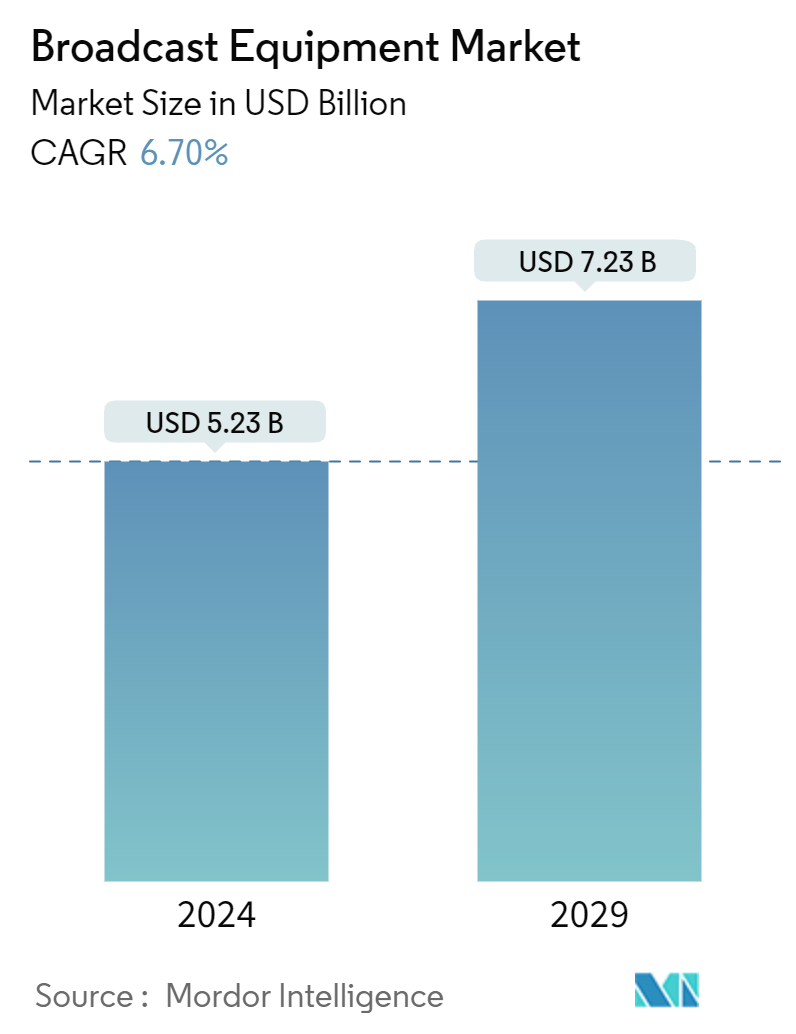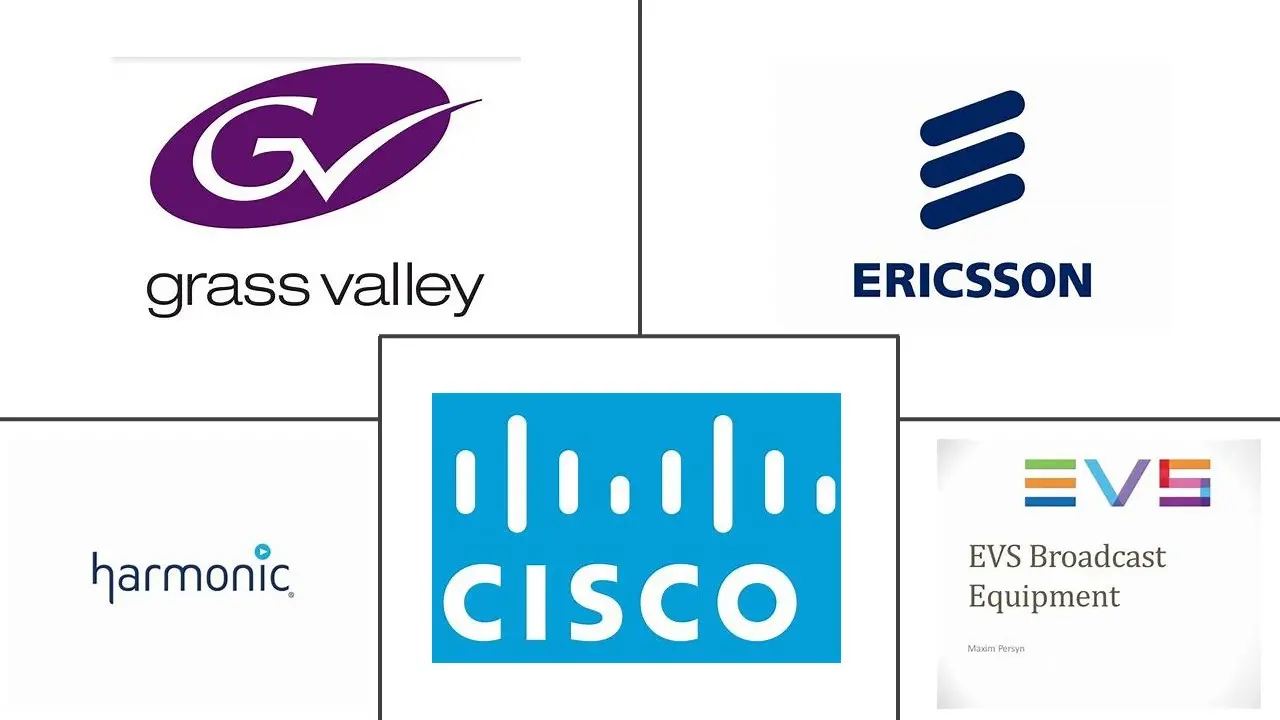Market Size of Broadcast Equipment Industry

| Study Period | 2019 - 2029 |
| Market Size (2024) | USD 5.23 Billion |
| Market Size (2029) | USD 7.23 Billion |
| CAGR (2024 - 2029) | 6.70 % |
| Fastest Growing Market | Asia-Pacific |
| Largest Market | North America |
Major Players
*Disclaimer: Major Players sorted in no particular order |
Broadcast Equipment Market Analysis
The Broadcast Equipment Market size is estimated at USD 5.23 billion in 2024, and is expected to reach USD 7.23 billion by 2029, growing at a CAGR of 6.70% during the forecast period (2024-2029).
The distribution of audio and video content to a precise audience via electronic mass communication is known as broadcasting. It is a spread of information to a large group of people. Typically, broadcasting is limited to a local spot network system. Broadcasting services, which remain popular, deliver a large audience with the most direct and reliable information mediums. The broadcast equipment market is expanding because of the increased use of smart electronic devices and improved demand for 3D and HD content.
- Over the last few decades, consumers' demand for better-quality audio and video has rapidly upgraded broadcast equipment products and technology. With content being produced in 4K and UHD formats, broadcasting in the identical format for enhanced viewing quality has resulted in IP live-production technology. This is essential for live production, where a premium is placed on flexible and efficient system control.
- For instance, in November 2023, the ArcGIS Motion Imagery Team announced the release of the new ArcGIS Video Server. This new server role for ArcGIS Enterprise is designed to expand video capabilities across ArcGIS. The latest ArcGIS Video Server allows indexing, publishing, searching, and streaming video as a service with geospatial and temporal context.
- Technological advancements are driving broadcasters to provide UHD output to their premium users, fueling market growth. Moreover, the rise in digital channels and the increasing utilization of cutting-edge broadcasting devices, featuring 8K video quality for sports coverage and 4K quality for news coverage, contribute to the acceleration of market growth. According to the 8K Association, 8K TVs will become increasingly popular in the coming years. Around 2.14 million 8K TV sets were shipped in 2023, up from 800 thousand in the previous year. By 2026, this number is predicted to reach over 4.4 million units.
- The sports section is the biggest market for TV viewers worldwide, and it is finding ways to deliver video content at scale. The increasing number of devices and formats offer several challenges for service providers, content owners, broadcasters, and rights holders. The rental sports broadcast equipment sector is also a significant revenue generator in the broadcast equipment market. The increasing number of international sports tournaments is driving the rental market for broadcast equipment.
- Furthermore, the market is witnessing opportunities for evolution due to evolving technology, increased investments in high-speed internet infrastructure, and growing demand for D2C offerings via OTT services. According to the International Telecommunication Union, as of 2023, 67% of the population in small island developing states (SIDS) used the internet, compared to 35% of the population in least developed countries (LDCs), while the internet penetration rate for those living in landlocked growing counties was at 39%. The global online access rate was 67%.
- Moreover, the rising income, increasing purchases of consumer durables, and the increasing availability of fast and cheap internet are expected to impact the market’s growth positively. As per IBEF, India, television is projected to constitute 40% of the Indian media market in 2024, trailed by digital advertising (12%), print media (13%), cinema (9%), and the OTT and gaming industries (8%). By 2025, it is anticipated that the number of linked intelligent televisions will reach around 40 to 50 million.
- The rapidly developing nature of digital audio and video formats and the need for open, domestic, or international agreement norms for generating and preserving digital video and audio are challenging the market's growth. Norms for digital audio and video formats and compression methods are evolving with every new advancement in digital technology.
- The COVID-19 pandemic forced broadcasters to rethink their approach to producing and delivering content - resulting in changes to staffing, technology stacks, and facilities. News broadcasting, for instance, adapted to the lockdown requirements of several nations, with several programs worldwide gathering experts’ input through consumer video technology. Broadcasting technologies also enabled programs and concerts during the pandemic. For instance, Lady Gaga organized an eight-hour event involving 100 musicians playing from their living rooms, bedrooms, and gardens.
Broadcast Equipment Industry Segmentation
Broadcasting is audio and video distribution to a broad audience using an electronic mass communication medium, usually radio waves. The broadcasting is done in a one-to-many format. Studio transmitter link, FM stereo generator, composite switcher, FM exciter, FM transmitter power amplifier, antenna combiner, antenna array, and antenna switcher are among the various broadcasting equipment required. They are used in news production, concerts, sports, and corporate conferences and are expected to be a critical factor in the growth of the broadcasting equipment market. The broadcast equipment market is segmented by technology (analog broadcasting, digital broadcasting), product (dish antennas, switches, video servers, encoders, transmitters, repeaters, and other products), and geography (North America, Europe, Asia-Pacific, Latin America, and Middle East and Africa). Further, factors affecting the market's evolution in the near future, such as drivers and constraints, have been covered in the study. The market sizes and predictions are provided in terms of value (USD) for all the above segments.
| By Technology | |
| Analog Broadcasting | |
| Digital Broadcasting |
| By Product | |
| Dish Antennas | |
| Switches | |
| Video Servers | |
| Encoders | |
| Transmitters and Repeaters | |
| Other Products |
| By Geography | |
| North America | |
| Europe | |
| Asia-Pacific | |
| Latin America | |
| Middle East and Africa |
Broadcast Equipment Market Size Summary
The broadcast equipment market is experiencing significant growth, driven by the increasing demand for high-quality audio and video content and the proliferation of smart electronic devices. As broadcasting evolves to include 3D, HD, 4K, and UHD formats, the need for advanced equipment such as encoders and IP live-production technology has become paramount. This demand is further fueled by the rise of digital channels and the popularity of streaming platforms, which require efficient encoding technologies to deliver high-quality video content. The market is also benefiting from technological advancements that enable broadcasters to offer UHD output and immersive experiences, such as virtual and augmented reality, enhancing viewer engagement and satisfaction.
The Asia-Pacific region is a key driver of market growth, with increasing urbanization, digitization, and internet penetration contributing to the demand for broadcast equipment. Major sporting events and the popularity of over-the-top (OTT) streaming platforms in the region are further propelling market expansion. The competitive landscape is characterized by intense rivalry among major players, with companies like Cisco Systems Inc., Telefonaktiebolaget LM Ericsson, and Harmonic Inc. leading the charge in innovation and strategic partnerships. The market's growth is also supported by investments in high-speed internet infrastructure and the rising income levels, which facilitate the adoption of advanced broadcasting technologies and consumer durables.
Broadcast Equipment Market Size - Table of Contents
-
1. MARKET INSIGHTS
-
1.1 Market Overview
-
1.2 Industry Attractiveness - Porter's Five Forces Analysis
-
1.2.1 Bargaining Power of Suppliers
-
1.2.2 Bargaining Power of Buyers
-
1.2.3 Threat of New Entrants
-
1.2.4 Threat of Substitutes
-
1.2.5 Intensity of Competitive Rivalry
-
-
1.3 Value Chain Analysis
-
1.4 Impact of Key Macroeconomic Trends on the Market
-
-
2. MARKET SEGMENTATION
-
2.1 By Technology
-
2.1.1 Analog Broadcasting
-
2.1.2 Digital Broadcasting
-
-
2.2 By Product
-
2.2.1 Dish Antennas
-
2.2.2 Switches
-
2.2.3 Video Servers
-
2.2.4 Encoders
-
2.2.5 Transmitters and Repeaters
-
2.2.6 Other Products
-
-
2.3 By Geography
-
2.3.1 North America
-
2.3.2 Europe
-
2.3.3 Asia-Pacific
-
2.3.4 Latin America
-
2.3.5 Middle East and Africa
-
-
Broadcast Equipment Market Size FAQs
How big is the Broadcast Equipment Market?
The Broadcast Equipment Market size is expected to reach USD 5.23 billion in 2024 and grow at a CAGR of 6.70% to reach USD 7.23 billion by 2029.
What is the current Broadcast Equipment Market size?
In 2024, the Broadcast Equipment Market size is expected to reach USD 5.23 billion.

